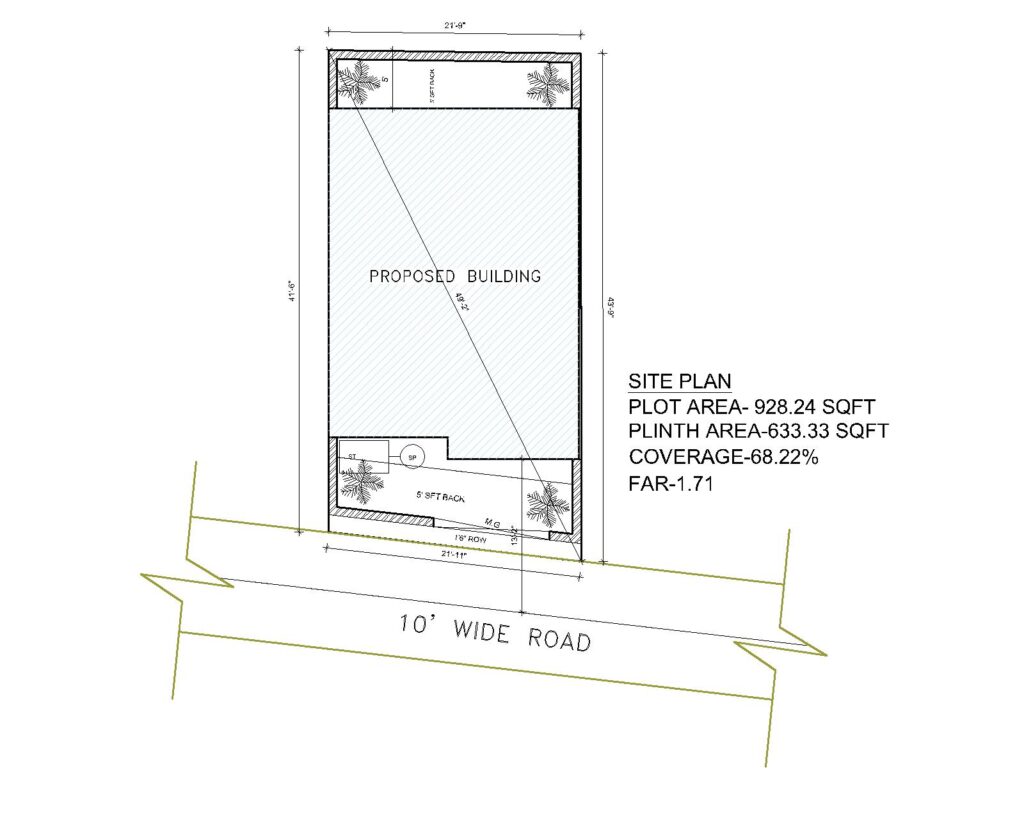From Ground Zero to Precision Marking
1. Site Preparation
a. Clear the Site
- Remove all vegetation, debris, and obstructions.
- Level the ground roughly using manual labor or a small excavator.
- Confirm plot boundaries using land survey documents to avoid encroachment.
b. Verify Legal Compliance
- Ensure your architectural plan matches the approved building permit from the municipality.
- Confirm setbacks (1.5m on all sides) and total permissible height for your plot size.
2. Tools You’ll Need
- Total Station (for precise measurements in Kathmandu’s uneven terrain).
- Auto Level Machine (to check ground leveling).
- Steel Pegs (for permanent markers).
- Nylon Thread and Chalk Powder (for temporary lines).
- Measuring Tape (30m+), Hammer, and Spray Paint (red/blue).
- 3-4-5 Triangle Calculator (or a measuring tape for manual checks).
3. Step-by-Step Layout Process
Step 1: Establish the Baseline
- Use the total station to mark the primary baseline (usually parallel to the road or plot boundary).
- Drive steel pegs at the two farthest corners of the building footprint.
- Stretch a nylon thread tightly between these pegs as your reference line.
Step 2: Mark Centerlines
- Mark the centerlines of all walls and columns using chalk powder or spray paint.
- Example: For a rectangular 1000 sqft (e.g., 25ft x 40ft) building:
- Measure 12.5ft from the baseline to mark the central axis.
- Repeat for perpendicular axes.
Step 3: Triangulation for Accuracy
- Kathmandu’s seismic risk demands perfect symmetry. Use triangulation:
- Mark two diagonal corners (A and C) and measure the diagonal distance (e.g., 50ft for 30-40-50 triangle).
- If the diagonal measurements (AC and BD) are equal, the layout is square.
Step 4: 3-4-5 Triangle Test for Right Angles
- To verify a 90° corner:
- From a corner peg, measure 3m along one axis and mark.
- Measure 4m along the perpendicular axis and mark.
- The diagonal between these points should be 5m. Adjust pegs until it’s precise.
Step 5: Mark Column Positions
- Divide the centerlines into equal segments for 12 columns.
- Example: For 25ft x 40ft, place 3 columns along the width and 4 along the length (spacing ~8-10ft).
- Use the total station to mark exact centers of each column with steel pegs.
Step 6: Set Batter Boards
- Install temporary batter boards (wooden stakes with horizontal crossboards) 2–3ft outside the building footprint.
- Stretch nylon threads between boards to outline all walls and columns. This keeps markings visible during excavation.
4. Excavation Guidance
- Manual vs. Machine Excavation:
- Use manual labor for soft soil (common in Kathmandu’s valleys) to save costs.
- Hire a hydraulic excavator for rocky terrain (common in hillside plots).
- Avoid Bulldozers: They’re for grading, not digging foundation trenches.
5. Critical Checks Before Pouring Concrete
- Re-measure diagonals to ensure the layout is square.
- Verify column positions with the total station.
- Check depths of excavation pits (1.5–4.5m, depending on soil report).
- Inspect for levelness using the auto-level machine.
Why This Works in Kathmandu
- Triangulation: Compensates for uneven terrain and seismic risks.
- 3-4-5 Method: Ensures load-bearing columns are perfectly aligned for earthquake resistance.
- Batter Boards: Survive monsoon rains and keep layout intact during digging.
Pro Tips for Kathmandu
- Work in Dry Seasons: Layout during October–April to avoid rain washing away markings.
- Local Materials: Use bamboo instead of batter boards for cost savings.
- Double-Check with Pros: Hire a licensed surveyor to approve the layout before excavation.
Tools Checklist
| Task | Tools |
|---|---|
| Baseline Marking | Total Station, Steel Pegs, Nylon Thread |
| Column Centers | Spray Paint, Hammer |
| Right Angles | 3-4-5 Triangle Method, Measuring Tape |
| Safety | Auto Level, Shoring for Trenches |
By following this guide, you’ll lay a faultless foundation for your 1000 sqft building, tailored to Kathmandu’s unique seismic and terrain challenges. Always cross-check with Nepal’s National Building Code (NBC 105: Seismic Design) and involve licensed engineers for critical sign-offs! 🏗️


